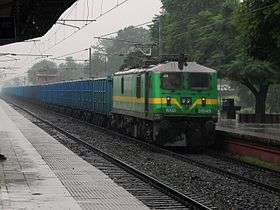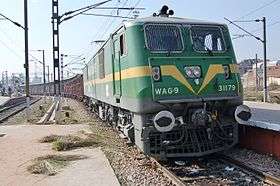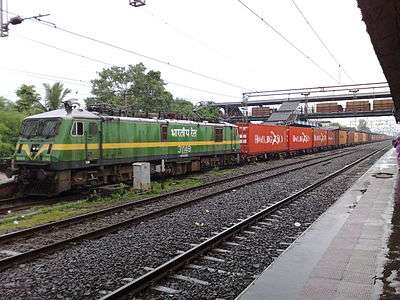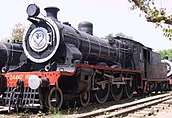Indian locomotive class WAG-9
| WAG-9[1] | |||||||||||||||||||||||||||||||||||||||
|---|---|---|---|---|---|---|---|---|---|---|---|---|---|---|---|---|---|---|---|---|---|---|---|---|---|---|---|---|---|---|---|---|---|---|---|---|---|---|---|
 An Lallaguda-based WAG9 hauling freight near Lingampally | |||||||||||||||||||||||||||||||||||||||
| |||||||||||||||||||||||||||||||||||||||
| |||||||||||||||||||||||||||||||||||||||
| |||||||||||||||||||||||||||||||||||||||
| |||||||||||||||||||||||||||||||||||||||
The WAG-9 is a type of electric locomotive used in the Indian Railway and the most powerful freight locomotive of the fleet. It is similar to the WAP-7, but feautres a different gear ratio which makes it suitable for heavy freight operations. In November 1998, the Chittaranjan Locomotive Works (CLW) started producing these with indigenous components. The first of which, named 'Navyug' (translated, 'New Era'), was produced on November 14, 1998. Like the WAP-5 units, the WAG-9 has GTO thyristor converters and three-phase asynchronous motors.
Newer versions of the WAG-9 feature full IGBT traction control; the debut model was the WAG-9 31248. The class as a whole is denoted by the WAG-9i prefix in its model number, although, there is a technical variant of this class named WAG-9H, with the 'H' meaning Heavy.
The WAG-9H/9Hi locomotives are the second heaviest in regular service in India, the only freight-dedicated three-phase AC locomotives in the country and the only electric locomotives in India fitted with Insulated Gate Bipolar Transistor (IGBT). They are also the freight locomotives with highest operational speed in India. The latest WAG 9 31086 is based in GOMOH(GMO) and has a unique red colored livery with G-9 written in large retro fonts.



Introduction
This locomotive is referred to as the "Heavy Haul" freight locomotive of the Indian Railways (IR). This locomotive was conceived owing to the extreme growth in the rail freight transportation sector. The growth in this sector is considered to be of great importance in the growth of the economy of India. This need had arisen the need for more electrification and electric locomotives in India. Around 60-65% of the freight haulage of IR takes place on the electrified section of the Golden Quadrilateral (Indian Railways) & diagonals (which account for 25% of the route). These are very busy routes, so clearance is a necessity. This power give it a great sectional clearance ability. Thus these locomotives are important for the Indian Railways.
These locomotives have entered the Western Railway zone of Mumbai. The first 22 units were imported from Adtranz (ABB). Of these, the first six were fully assembled and rest were in kit form. Again in the kit form, seven were completely knocked down and rest partially assembled. CLW started producing these traction motors on 11/1/1999. The units built by ABB have double-pan pantographs while the CLW built units have single pan pantographs which are common in India. This class had a capacity to MU several units but IR restricts them to two because of dynamic loading restriction on most bridges. Regenerative brakes provide about 260 kN of braking effort.
The WAG-9H also has different application software to the WAG-9. The first WAG-9H was commissioned on 30 June 2000. The #30130 prototype was homed at Gomoh (GMO) this was then converted back to standard WAG-9 in 2002. This unit has a livery of twin white stripes on green instead of yellow stripe on green seen on the other WAG-9(x)s.
The WAG-9i was introduced in 2010 #31215 homed at the GMO shed. With IGBT, even if one traction motor failed, other traction motors can function with a total output of 5500 hp.
Newer WAG-9 units have 'CLW Glorious 50 years' marked on their sides. Some WAG-9(x)s are fitted with a solid cowcatcher while others are fitted with grilled cowcatchers. Some have American style flasher lamps while others have Indian style flasher lamps. If you want additional information about this loco try this link http://elocos.railnet.gov.in/Study_Material/TSD_3Ph.pdf
Technical specifications
The WAG-9 technical specifications are:[2]
| Traction Motors | ABB's 6FRA 6068 (850 kW, 2180V, 1283/2484 rpm, 270/310A. Weight 2100 kg) Axle-hung, nose-suspended, Class 200 Insulation, Forced Air Ventilation |
| Gear Ratio | 77:15 / 64:18 / 107:21 |
| Transformer[3] | ABB's LOT 6500, Class A Insulation, OFAF cooling, Primary (25 kV, 6531 kVA), Secondary rating(4x1269 V, 4x1450 kVA, 4x1142 A), Auxiliary (1000 V, 334 kVA, 334 A), Filter (1154 V, 400 kVA, 347 A), 9,450 kg (20,830 lb) |
| 2 Power Drives | WAG-9/9H : Power converter from ABB, type UW-2423-2810 with SG 3000G X H24 GTO thyristors (D 921S45 T diodes), 14 thyristors per unit (two units), OFAF cooling. Line converter rated at 2 x 1269V @ 50 Hz (more or less 3%), with DC link voltage of 2800V(nominal). Motor/drive converter rated at 2180 V phase to phase, 971 A output current per phase, motor frequency from 0 to 132 Hz.
WAG-9i : IGBT |
| Bogies | (Design later used for IORE and China Railways HXD3B; bogie wheelbase 1,850 mm (72 7⁄8 in) + 1,850 mm (72 7⁄8 in) |
| Unsprung mass per axle | 3.984 t (3.921 long tons; 4.392 short tons) |
| Loco Weight | 123 t (121 long tons; 136 short tons) wag9 / 135 t (133 long tons; 149 short tons) wag 9h |
| Length over head-stocks | 19,280 mm (63 ft 3 in) |
| Distance between axles of bogie | 1,850 mm (72 7⁄8 in) |
| Cab length | 2,434 mm (95 7⁄8 in) |
| Pantographs | Two Secheron ES10 1Q3-2500, 186 kg (410 lb) (without insulators). |
| Drive Arrangement | Gear Pinion |
| 2 HCBO-605-115 type Traction Motor Blowers by Flakt and ABB | 4.05 m3/s (143 cu ft/s) and 416 kg (917 lb) |
| Traction Motor Blower Motors of 200L55-RFXH2A-D1 type by Landert | 3 phase, 415 V, 50 Hz, 2930 rpm, 25 kW (34 hp) and Class F insulation |
| 2 Oil Cooler Blowers by Behr | 4.05 m3/s (143 cu ft/s). |
| Oil Cooler Blower Motors of 200L55-RH2A type by Landert | 3 phase, 415 V, 50 Hz, 2930 rpm, 25 kW (34 hp) and Class F insulation |
| 2 TAO8-2174/15 type Transformer Oil Pumps by Fumettaz | 1,000 L/min (220 imp gal/min; 260 US gal/min) |
| Transformer Oil Pump Motors by Landert of 112M-2B type | 3 phase, 415 V, 50 Hz, 2930 rpm, 4.7 kW (6.3 hp) and Class F insulation |
| 2 TC10-2185/29 type Converter Oil Pumps by Plumettaz | 960 L/min (210 imp gal/min; 250 US gal/min) |
| 112M-2F type Converter Oil Pump Motors by Landert | 3 phase, 415 V, 50 Hz, 2860 rpm, 11 kW (15 hp)., 95 kg (209 lb) and Class F insulation |
| 2 2A3200 C13-T32 type Main Compressors by D&M | 1,745 L/min (384 imp gal/min; 461 US gal/min), 10 kg/cm (2,000 lb/yd), 600 kg (1,300 lb), and 15 kW (20 hp), |
| Main Compressor Motors of 200l55-RPAH8B type by Landert | 3 phase, 415 V, 50 Hz, 730 rpm, 15 kW (20 hp), and Class H insulation |
| 2 HCBO-415-60 type Machine Room Blowers by Flakt and ABB | 1 m3/s (35 cu ft/s), 140 kg (310 lb), 415 VAC and maximum temperature rise of 80 degrees Celsius (176 degrees Fahrenheit) |
| 132M-RFXHE2C type Machine Room Blower Motors by Landert | 1 phase, 415 V, 50 Hz, 2830 rpm, 28 kW (38 hp) and Class F insulation |
| FF 3145 type Auxiliary Compressor by D&M and Bristol | 7.03 kg/cm2 (100.0 psi) and 50 kg (110 lb) |
| Auxiliary Compressor Motor by D&M | 110 V DC, 50 Hz, 1450 rpm and 0.75 kW (1.01 hp) (Air Dryer provided) |
| Ni-Cd(SAF-39 SBL 199) type Battery by Saft Groupe S.A. and Nife | 110 V DC + 20% / -30%, 5 hrs discharging and 78 cells |
| BUR 10 A 100 LVPS type Auxiliary Converter by ABB | 3 phase, 415 V and 100 kVA |
| Nominal supply voltage | 22.5 kV |
| Normal variation in supply voltage | 19-27.5 kV |
| Occasional maximum voltage | 31 kV (15 min) |
| Occasional minimum voltage | 16.5 kV (15 min) |
| Variation in supply frequency | More or less 8% (46–54 Hz) |
| Distance between neutral section | 25–50 km (16–31 mi) |
| Types of neutral section | 41 m (135 ft), insulated overlap on both ends and neutral wire which is not earthed OR
4.61–9.6 m (15.1–31.5 ft), insulated portion of Polytetrafluoroethylene on both sides and middle portion of neutral section which is solidly earthed |
| Pantograph bounce | <45 m (148 ft) |
| Devices on the track | Tracks should have DC track circuits. Devices such as axle counters, block instruments and point machines may be employed |
| Communication network | Control circuits, teleprinter circuits, VHF/UHF and micro-wave circuits may be employed |
| Temperature of atmosphere | −10 to 50 degrees Celsius (14 to 122 degrees Fahrenheit) |
| Temperature of atmosphere in direct sunlight | 75 degrees Celsius (167 degrees Fahrenheit) |
| Temperature of atmosphere in shade | 55 degrees Celsius (131 degrees Fahrenheit) |
| Temperature inside dead locomotive while exposed to direct sunlight | 70 degrees Celsius (158 degrees Fahrenheit) |
| Dust concentration in terrain | Up to 0.0016 mg/L (5.8×10−11 lb/cu in) |
| Operation in flood | At 10 km/h (6.2 mph) with water of 102 mm (4 in) above rail level |
| pH value in atmosphere | 8.5 |
| Sulphate in atmosphere | 7 mg/L (2.5×10−7 lb/cu in) |
| Chlorine in atmosphere | 6 mg/L (2.2×10−7 lb/cu in) |
| Conductivity in atmosphere | 130 micro Siemens/cm |
| Altitude of operation | Between 160 m (520 ft) above sea level and sea level |
| Vibration in traction motors | 300 g (worn gear-pinion) |
| Starting resistance of BOXN wagons excluding locomotive on level track | 4 kg/ton |
| Starting resistance of locomotive on level track | 6 kg/ton |
| Rate of change of tractive effort | 20 kN/sec |
| Rate of change of braking effort | 100 kN/sec |
| Efficiency of line converter at continuous speed for full load | 97% |
| Buffing load | 400 tonnes (390 long tons; 440 short tons) |
| Ground clearance above rail with full load and full worn wheels | 102 mm (4.016 in) |
| Traveling distance annually | 200,000 km (120,000 mi) |
| Life | 35 years |
| Sandboxes | 50 kg (110 lb) each |
| Max difference in diameter of wheels on the same axle | 0.5 mm (0.020 in) |
| Max difference in wheels of the same bogie | 4 mm (0.157 in) |
| Overall max difference of diameter of wheels | 20 mm (0.787 in) |
| Train brakes | 242 kN (54,000 lbf), 35% adhesion |
| Parking brake force | 37 kN (8,300 lbf) |
| Auxiliary reservoir | 135 kg (298 lb) |
| Scavenge blower to traction motor blower | 42 kg (93 lb) |
| Oil cooling unit | 930 kg (2,050 lb) |
| Scavenge blower to machine room blower | 37 kg (82 lb) and 415 V AC |
| Cubicle auxiliary circuits 1 | 220 kg (490 lb) |
| Cubicle control circuits 1 | 160 kg (350 lb) |
| Central electronics 1 | 32.34 kg (71.3 lb) |
| Main reservoir | 330 kg (730 lb) |
| Central Electronics 2 | 31.34 kg (69.1 lb) |
| Cubicle control circuits 2 | 170 kg (370 lb) |
| Cubicle auxiliary circuits 2 | 105 kg (231 lb) |
| Filter cubicle | 400 kg (880 lb) |
| Cab heater and crew fans | 110 VAC |
| Fire alarm | 1170 Hz |
| Dials illumination level | 10-90% |
| Heater capacity | 2.2 kW (3.0 hp) |
Sheds Holding WAG-9
- Gomoh (GMO)
- Ajni (AJNI)
- Kazipet (KZJ)
- Lallaguda (LGD)
- Bhilai (BIA)
- Tata Nagar (TATA)
- Tughlakabad (TKD)
- Kalyan (KYN)
- Visakhapatnam (VSKP)
- Vadodara (BRC)
- Ludhiana (LDH)
- Kanpur (CNB)
- New Katni (NKJ)
- Bhusaval (BSL)
- Bondamunda (BNDM)
Named Locos
- WAG-9 31022 Pavan
- WAG-9 31023 Navjyoti
- WAG-9 31024 Navdisha
- WAG-9 31030 Navshakti
- WAG-9 31033 Navoday
- WAG-9 31058 Nav Ghanshakti
- WAG-9 31086 Dr Silver
- WAG-9 31100 Navshatak
- WAG-9 31112,31121 Navpragati
- WAG-9 31162 Nav Shakti
- WAG-9 31215,31255 Naveen
- WAG-9 31475 Ashok
Performance
Two WAG-9 class units can haul a load of 4,500 tonnes (4,400 long tons; 5,000 short tons) on grades of 1 in 60 (1.67%). The WAG-9H was expected to haul 58 BOXN wagons, i.e.,4,700 tonnes (4,600 long tons; 5,200 short tons) without multiple units on grades of 1 in 150 (0.67%). The locomotive can run even in 100% humidity or in deserts where there is high saturation of conductive particles. For shunting up to 15 km/h (9.3 mph), it can haul 7,500 tonnes (7,400 long tons; 8,300 short tons) on grades of 1 in 1000 (0.1%) or less. The atmosphere may be humid and salty. Regenerative braking will provide braking force of no less than 260 kN (58,000 lbf) at 10–62 km/h (6.2–38.5 mph) and closer to 260 kN (58,000 lbf) at higher speeds. Below is the capacity of the WAG-9 while hauling BOX wagons (in tonnes}):[4]
| Grade\km/h | Start | 20 | 30 | 40 | 50 | 60 | 70 | 80 | 90 | 100 |
|---|---|---|---|---|---|---|---|---|---|---|
| Level | 6000+ | 6000+ | 6000+ | 6000+ | 6000+ | 6000+ | 6000+ | 6000+ | 6000+ | 6000+ |
| 1 in 500 | 6000+ | 6000+ | 6000+ | 6000+ | 6000+ | 6000+ | 6000+ | 4985 | 4150 | 3500 |
| 1 in 200 | 5060 | 5060 | 5060 | 5060 | 5060 | 4045 | 3325 | 2780 | 2365 | 2040 |
| 1 in 150 | 4250 | 4250 | 4165 | 4080 | 3985 | 3200 | 2640 | 2220 | 1895 | 1640 |
| 1 in 100 | 3205 | 2910 | 2870 | 2825 | 2775 | 2240 | 1855 | 1565 | 1345 | 1165 |
| 1 in 50 | 1820 | 1455 | 1445 | 1435 | 1420 | 1440 | 945 | 795 | 680 | 590 |
See also
References
External links
| Wikimedia Commons has media related to Indian locomotive class WAG9. |


_Sathavahana_Express_at_Ghatkesar.jpg)
